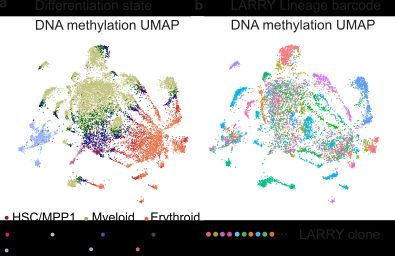
Lars Velten
@larsplus.bsky.social
Group leader @crg.eu | blood, single cell, synthetic genomics
@martinabraun.bsky.social showed that in human a) clonal expansions are ubiqutious by age 50 and b) CH mutation linked clones are just a small subset of clonal expansions, with similar functional biases as “driverless” clones (9/n)

May 21, 2025 at 3:44 PM
@martinabraun.bsky.social showed that in human a) clonal expansions are ubiqutious by age 50 and b) CH mutation linked clones are just a small subset of clonal expansions, with similar functional biases as “driverless” clones (9/n)
We then built an algorithm, EPI-Clone, that extracts clonal information from scTAM-seq data. It recapitulates ground truth clonal labels with high accuracy. This was more or less our preprint, online since April 2024. Since then a lot has happened: (7/n)

May 21, 2025 at 3:44 PM
We then built an algorithm, EPI-Clone, that extracts clonal information from scTAM-seq data. It recapitulates ground truth clonal labels with high accuracy. This was more or less our preprint, online since April 2024. Since then a lot has happened: (7/n)
This made us wonder if these two layers can be separated. Again to our surprise, we discovered that the CpGs that change with differentiation (“dynamic” CpGs) are different from the ones that are clone-specific (“static CpGs”) (5/n)

May 21, 2025 at 3:44 PM
This made us wonder if these two layers can be separated. Again to our surprise, we discovered that the CpGs that change with differentiation (“dynamic” CpGs) are different from the ones that are clone-specific (“static CpGs”) (5/n)
We performed targeted single-cell profiling of 453 CpGs on cells that had been barcoded with a lentivirus, so we knew clonal identity. To our big surprise, these data clustered both by differentiation state, and by clone. (4/n)

May 21, 2025 at 3:44 PM
We performed targeted single-cell profiling of 453 CpGs on cells that had been barcoded with a lentivirus, so we knew clonal identity. To our big surprise, these data clustered both by differentiation state, and by clone. (4/n)
Across all 42 TFs, we systematically quantified antagonsims and synergies: Non-additive and neutralizing interactions are much more common in primary cells than in a cancer cell lime, where most combinations activate.

May 8, 2025 at 4:07 PM
Across all 42 TFs, we systematically quantified antagonsims and synergies: Non-additive and neutralizing interactions are much more common in primary cells than in a cancer cell lime, where most combinations activate.
Using these data, we constructed an AI that can create new enhancers that work as predicted (10/n)

May 8, 2025 at 4:07 PM
Using these data, we constructed an AI that can create new enhancers that work as predicted (10/n)
These negative synergies create a sensor of TF ratios. If one TF’s expression dominates, you get activation. If both are there, repression. A perfect design to ensure that target genes are expressed specifically at the right place. (9/n)

May 8, 2025 at 4:07 PM
These negative synergies create a sensor of TF ratios. If one TF’s expression dominates, you get activation. If both are there, repression. A perfect design to ensure that target genes are expressed specifically at the right place. (9/n)
We found (functional and alphafold) evidence that direct TF-TF interactions may be involved (8/n)

May 8, 2025 at 4:07 PM
We found (functional and alphafold) evidence that direct TF-TF interactions may be involved (8/n)
Combinatorial enhancers do something even more crazy: In several cases, pairs of strong, universal activators turn into cell state specific repressors. Here are the two most extreme cases: (7/n)

May 8, 2025 at 4:07 PM
Combinatorial enhancers do something even more crazy: In several cases, pairs of strong, universal activators turn into cell state specific repressors. Here are the two most extreme cases: (7/n)
To dissect this behavior, we classified TFs into activators, repressors, or dual factors. To our surprise, some TFs are activators at low occupancy, and Repressors at high occupancy. For in-depth biophysical modelling by @rmartinezcorral.bsky.social , see our paper! (6/n)

May 8, 2025 at 4:07 PM
To dissect this behavior, we classified TFs into activators, repressors, or dual factors. To our surprise, some TFs are activators at low occupancy, and Repressors at high occupancy. For in-depth biophysical modelling by @rmartinezcorral.bsky.social , see our paper! (6/n)
When we looked at the activity of our constructs, we found that enhancers composed of binding site pairs are often highly cell state specific, whereas enhancers composed of single sites are not. (5/n)

May 8, 2025 at 4:07 PM
When we looked at the activity of our constructs, we found that enhancers composed of binding site pairs are often highly cell state specific, whereas enhancers composed of single sites are not. (5/n)
We used synthetic DNA to reduce complexity. Specifically, we placed sites for 38 TFs in a random DNA background, at different combinations and arrangements. We measured the activity of these constructs in 7 cell states of hematopoietic stem cell differentiation. (4/n)

May 8, 2025 at 4:07 PM
We used synthetic DNA to reduce complexity. Specifically, we placed sites for 38 TFs in a random DNA background, at different combinations and arrangements. We measured the activity of these constructs in 7 cell states of hematopoietic stem cell differentiation. (4/n)
During hematopoiesis, TFs are expressed in continuous and overlapping gradients. Nonetheless, their targets are highly cell state specific. How can that be? (2/n)

May 8, 2025 at 4:07 PM
During hematopoiesis, TFs are expressed in continuous and overlapping gradients. Nonetheless, their targets are highly cell state specific. How can that be? (2/n)

